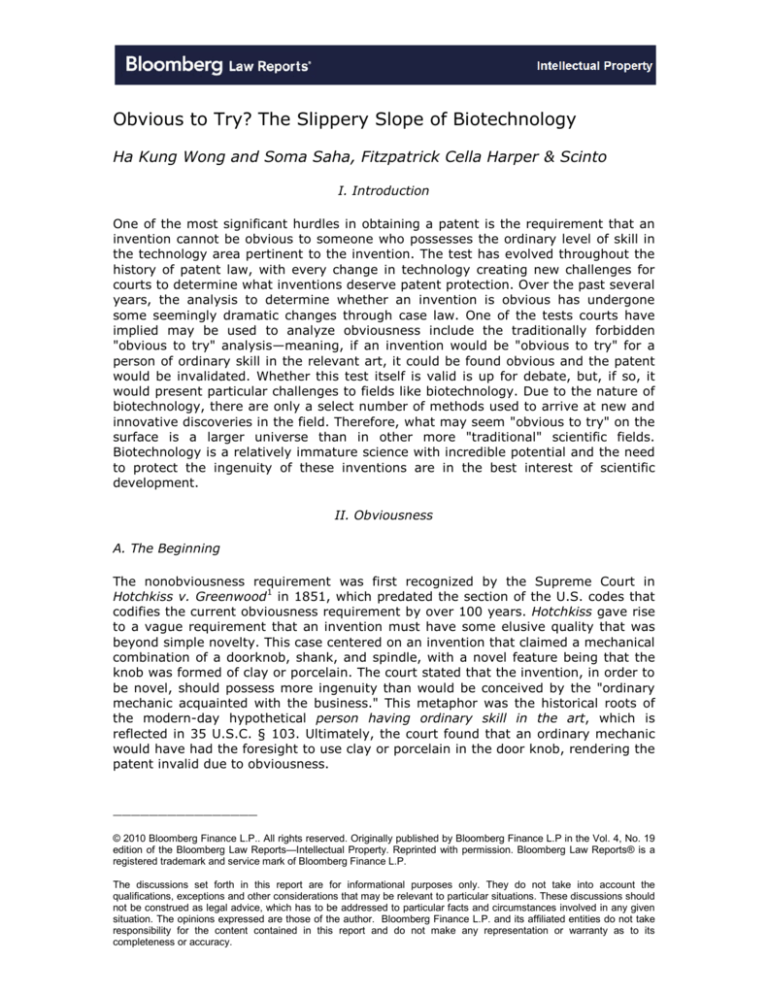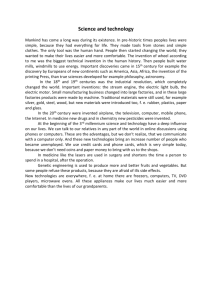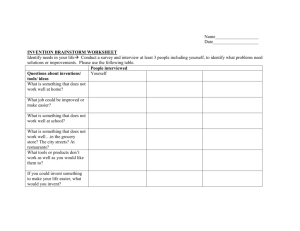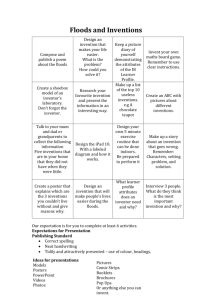
Obvious to Try? The Slippery Slope of Biotechnology
Ha Kung Wong and Soma Saha, Fitzpatrick Cella Harper & Scinto
I. Introduction
One of the most significant hurdles in obtaining a patent is the requirement that an
invention cannot be obvious to someone who possesses the ordinary level of skill in
the technology area pertinent to the invention. The test has evolved throughout the
history of patent law, with every change in technology creating new challenges for
courts to determine what inventions deserve patent protection. Over the past several
years, the analysis to determine whether an invention is obvious has undergone
some seemingly dramatic changes through case law. One of the tests courts have
implied may be used to analyze obviousness include the traditionally forbidden
"obvious to try" analysis—meaning, if an invention would be "obvious to try" for a
person of ordinary skill in the relevant art, it could be found obvious and the patent
would be invalidated. Whether this test itself is valid is up for debate, but, if so, it
would present particular challenges to fields like biotechnology. Due to the nature of
biotechnology, there are only a select number of methods used to arrive at new and
innovative discoveries in the field. Therefore, what may seem "obvious to try" on the
surface is a larger universe than in other more "traditional" scientific fields.
Biotechnology is a relatively immature science with incredible potential and the need
to protect the ingenuity of these inventions are in the best interest of scientific
development.
II. Obviousness
A. The Beginning
The nonobviousness requirement was first recognized by the Supreme Court in
Hotchkiss v. Greenwood1 in 1851, which predated the section of the U.S. codes that
codifies the current obviousness requirement by over 100 years. Hotchkiss gave rise
to a vague requirement that an invention must have some elusive quality that was
beyond simple novelty. This case centered on an invention that claimed a mechanical
combination of a doorknob, shank, and spindle, with a novel feature being that the
knob was formed of clay or porcelain. The court stated that the invention, in order to
be novel, should possess more ingenuity than would be conceived by the "ordinary
mechanic acquainted with the business." This metaphor was the historical roots of
the modern-day hypothetical person having ordinary skill in the art, which is
reflected in 35 U.S.C. § 103. Ultimately, the court found that an ordinary mechanic
would have had the foresight to use clay or porcelain in the door knob, rendering the
patent invalid due to obviousness.
________________
© 2010 Bloomberg Finance L.P.. All rights reserved. Originally published by Bloomberg Finance L.P in the Vol. 4, No. 19
edition of the Bloomberg Law Reports—Intellectual Property. Reprinted with permission. Bloomberg Law Reports® is a
registered trademark and service mark of Bloomberg Finance L.P.
The discussions set forth in this report are for informational purposes only. They do not take into account the
qualifications, exceptions and other considerations that may be relevant to particular situations. These discussions should
not be construed as legal advice, which has to be addressed to particular facts and circumstances involved in any given
situation. The opinions expressed are those of the author. Bloomberg Finance L.P. and its affiliated entities do not take
responsibility for the content contained in this report and do not make any representation or warranty as to its
completeness or accuracy.
35 U.S.C. Section 103 was created in 1952. Section 103 codified the language in
Hotchkiss regarding the requirement that the invention not be obvious to a person
with ordinary skill in the art ("POSA") in order to be patentable. Almost fifteen years
after the enactment of section 103, the U.S. Supreme Court interpreted the
obviousness codification by developing an analytical framework for determining the
issue of nonobviousness in Graham v. John Deere.2 They established four factors
that are essential elements to a judicial obviousness determination: (1) determining
the ordinary level of skill in the art; (2) scope and content of prior art; (3)
differences between the claimed art and the prior art; and (4) secondary
considerations, which include commercial success, long felt but unsolved needs,
and/or failure of others to invent. Later, in evaluating differences between the
claimed invention and the prior art, the U.S. Court of Appeals for the Federal Circuit
has applied in certain cases, the teaching, suggestion, or motivation ("TSM") test.
This test was devised by the Federal Circuit as a uniform method that involves asking
whether there was specific reason at the time of the invention found either in the
prior art or the knowledge of POSA to make a change to the prior art or to combine
prior art to make the invention at issue. If there was no such teaching, suggestion,
or motivation, then prima facie obviousness can be overcome. It was also developed
to guard against hindsight bias that potentially occurs when evaluating prior art
many years after the fact. Hindsight bias is essentially what it sounds like—using the
knowledge of how a product was invented to demonstrate why it was obvious.
B. "Obvious to try"
Since Section 103 was enacted, the obviousness analysis has undergone several
changes, with the TSM as the backbone of all analyses. The court has struggled to
find the balance between allowing patents for inventions that are meaningful
advances in science and weeding out the ones that do not contribute to scientific
progress. The court has wavered in its view as to whether the "obvious to try"
standard is sufficient to determine whether an invention deserves the right of patent
protection. The standard was first tested in the Federal Circuit in 1988, in In re
O'Farrell where the court stated: "[a]ny invention that would in fact have been
obvious under § 103 would also have been, in a sense, obvious to try. The question
is: when is an invention that was obvious to try nevertheless nonobvious?"3 The
court split the world of inventions that would seem as though they could be "obvious
to try" on the surface into two categories. The first category contained a known
method of discovering the invention, and the inventor varied all the possible
parameters until a successful result included the claimed invention. In this scenario,
no teaching, motivation, or suggestion was provided in the prior art. In these cases,
inventions were clearly not obvious under § 103. The second universe of inventions
involved inventions where the inventor was exploring a promising experimental area,
where only general guidance as to the particular form of the invention was given in
the prior art. In these cases, if there was no reasonable expectation of success for
any particular part of the claimed invention, then the patent was not obvious. The
court emphasized that the obviousness inquiry should focus on the reasonable
expectation of success and not the predictability of success. For years after O'Farrell,
the court was silent on whether "obvious to try" could be used in the obviousness
inquiry.
In 1995, the Federal Circuit was faced with a classic biotechnology invention of
isolating DNA molecules to encode proteins to repair or replace damaged tissue in
the case In re Deuel. The prior art outlined the general method to isolate DNA
© 2010 Bloomberg Finance L.P.. All rights reserved. Originally published by Bloomberg Finance L.P in the Vol. 4,
No. 19 edition of the Bloomberg Law Reports—Intellectual Property. Reprinted with permission. Bloomberg Law
Reports® is a registered trademark and service mark of Bloomberg Finance L.P.
sequences; however, the prior art did not suggest the claimed compound. The court
revisited "obvious to try" as a standard and clearly stated that, "'[o]bvious to try' has
long been held not to constitute obviousness . . . [a] general incentive does not
make obvious a particular result, nor does the existence of techniques by which
those efforts can be carried out."4 It appeared "obvious to try" was no longer a
potential measure of obviousness. The court resumed using only the TSM test to
determine obviousness.
Twelve years later, the U.S. Supreme Court revisited this issue in KSR v. Teleflex5
when they altered the long standing, formulaic tenants of obviousness by discarding
"rigid or mandatory formulas" in obviousness analysis. KSR involved a vehicle pedal
assembly including an electronic sensor for detection of the position of the pedal. The
pedals and sensors were individually known in the art. The court believed that
granting a patent for inventions that "would occur in the ordinary course without real
innovation" would retard scientific progress. The Supreme Court reasoned that
constricted analyses that do not allow courts to inquire whether an invention is
"obvious to try" are an incorrect interpretation of the law. The court stated:
When there is a design need or market pressure to solve a
problem and there are a finite number of identified, predictable
solutions, a person of ordinary skill has a good reason to pursue
the known options within his or her technical grasp. If this leads to
anticipated success, it is likely the product not of innovation but of
ordinary skill and common sense. In that instance the fact that a
combination was obvious to try might show that it was obvious
under § 103.6
KSR loosened the TSM test that was the central tenant of the obviousness analysis,
creating a more flexible test in its wake. The question remained whether KSR
resurrected the "obvious to try" standard.
After KSR, courts struggled to interpret the outer bounds of this flexible obviousness
test to come up with their own language to bring definition to an amorphous inquiry.
The "obvious to try" language began reappearing in biotechnology cases. In OrthoMcNeil Pharmaceuticals v. Mylan,7 the court found the lower court did not apply the
obviousness tests too strictly when they did not use an "obvious to try" standard.
"KSR posits a situation with a finite, and in the context of the art, small or easily
traversed, number of options that would convince an ordinarily skilled artisan of
obviousness."8 They reasoned when the Supreme Court decided to instill a less rigid
analysis to determine obviousness, they meant to take all the evidence on the record
as a whole and not single out any particular teaching, suggestion, or motivation as
the deciding factor. A limited number of options to the inventor could lead to a
conclusion that the invention was obvious to try.
In April of 2009, the Federal Circuit was once again faced with the classic
biotechnology question of whether the isolation and sequencing of a human gene
that encodes a particular domain of a protein is a patentable, nonbovious invention
in the case In re Kubin. In light of KSR, it was apparent that "'obvious to try' may be
an appropriate test in more situations than [they had] previously contemplated."9
The court noted that KSR's "admonition against a formalistic approach to
obviousness"10 resurrected the "obvious to try" analysis in O'Farrell. The court
© 2010 Bloomberg Finance L.P.. All rights reserved. Originally published by Bloomberg Finance L.P in the Vol. 4,
No. 19 edition of the Bloomberg Law Reports—Intellectual Property. Reprinted with permission. Bloomberg Law
Reports® is a registered trademark and service mark of Bloomberg Finance L.P.
reiterated the two situations where "obvious to try" did not equate to obviousness.
Obviousness is not a result of "throw[ing] metaphorical darts at a board filled with
combinational prior art possibilities[.]"11 Nor is it the result of general guidance in the
prior art of a particular field, without an indication to examine the claimed
compound. The court explicitly expressed that this type of analysis will not deem an
entire body of inventions in a scientific field irrelevant because the nature of the field
uses known methods to arrive at new inventions. They reiterated that each case
should be analyzed on a factual basis, where the abilities of artisans of ordinary skill
in the art will determine what is and is not a truly nonobvious invention.
In the cases since KSR and Kubin,12 courts focus on whether the prior art identifies a
finite number of identifiable, predictable solutions to determine obviousness. If
general guidance is given in the prior art, then courts will focus on the reasonable
expectation of success, as opposed to the predictability of success in their
obviousness analysis.13
III. The Slippery Slope
Most recently, in March of 2010, the court in the U.S. District Court for the Southern
District of New York found in Association for Molecular Pathology v. USPTO that
isolated human genes in the form of DNA, and the comparison of their sequences,
are not patentable under 35 U.S.C. § 101.14 Although this case does not pertain
directly to obviousness, it has potential to be used in a much wider context than
intended by the court. The case centered around two genes that are used to analyze
a woman's risk of getting breast or ovarian cancer. Because of the importance of this
technology, this case drew attention from a wide variety of organizations, including
companies that specialize in biotechnology products, scientific associations,
physicians that use genetics to screen their patients from diseases, and various
cancer organizations.
A long standing tenant of patent law is that a product of ordinary skill is not
necessarily a product of invention.15 The court in this case reasoned that for an
invention to be patentable, the results in the creation of the invention should yield a
fundamentally new product. The court's analysis turned on the test used in the
Supreme Court case Diamond v. Chakrabarty,16 where the court stated that a new
product produced should have "markedly different characteristics from any found in
nature and . . .[have] the potential for significant utility."17 Prior case law found that
purification of a product in nature does not create enough transformation to justify
patent protection, because such a change is not sufficient to create the "markedly
different characteristic" to deem it a true invention.18 The court found that isolated
DNA is not "markedly different" from native DNA as it exists in nature. They also
found the method claims which were directed to the method for determining whether
a patient carried the cancerous DNA mutations, were also not patentable under
Section 101. Method claims are patentable if they are tied to a machine or
apparatus; or, they transform an article to a different state or thing. The court found
"analyzing" and "comparing" DNA sequences was not a meaningful transformation
under the second part of this test. "[T]ransformation must be central to the purpose
of the claimed process."19
Ultimately, the claims-in-suit were found invalid under Section 101 because they
were not deemed to be patentable subject matter. Although the patenting of DNA
© 2010 Bloomberg Finance L.P.. All rights reserved. Originally published by Bloomberg Finance L.P in the Vol. 4,
No. 19 edition of the Bloomberg Law Reports—Intellectual Property. Reprinted with permission. Bloomberg Law
Reports® is a registered trademark and service mark of Bloomberg Finance L.P.
sequences found in nature was unpatentable, the decision did not necessarily
preclude patenting DNA fragments with altered sequences, and left open the
question whether adding start codons, promoters, or incorporating the DNA into a
vector would be considered something beyond what is found in nature. This case will
certainly find its way through the appeals process, as it is venturing into what some
might characterize as new and unique applications of the law. Although the court
firmly stated that the obviousness analysis is a separate and distinct requirement
under patent law20; there is danger that some courts may read this holding more
broadly to support obviousness opinions disguised under the "obvious to try"
rhetoric, i.e., it is obvious to try to obtain biotechnology products found in nature
regardless of the knowledge of its existence or the difficulty or motivation to obtain
it. This is a danger that should be carefully avoided, as such an inappropriate
determination would reduce the incentive to invest in this type of technology and
perhaps hinder its ability to grow and flourish.
IV. Protecting Biotechnology Inventions
The question remains: "How do I best prepare myself for the rigors of KSR and the
potential pitfalls of 'obvious to try' when dealing with biotechnology based
inventions?" The test for obviousness is not easily defined and is even more difficult
when considering the complexities of biotechnology. On the surface, it would seem
difficult to successfully defend against allegations of obviousness in this field.
However, there are steps biotechnology practitioners can take to mitigate the
chances of their patent being found invalid due to obviousness. As we have seen in
the case law presented above, the court will take into account the entire process
used to research and discover the invention when determining whether an invention
is obvious. Therefore, clearly documenting all results leading to the invention,
including those that ended unsuccessfully, is important in demonstrating that there
was more than a single "obvious" solution to the problem addressed by the
invention.
Another source of guidance could be the long standing secondary indicia of nonobviousness from the Supreme Court's Graham v. John Deere.21 Documentation of
failure of others, long felt unmet need, commercial success and how others in the art
react to the invention can all be good sources of potential protection from the
dangers of the elusive "obvious to try" concept. These are particularly useful in the
biotechnology arena as they can be used to demonstrate the difficulties,
complexities, and unpredictability of working in this field. And old standbys, such as
teachings away in prior art can also be helpful. This again demonstrates that, as the
saying goes, the more things change, the more they stay the same.
V. Conclusion
For any scientific field to progress and flourish, as is the case in biotechnology,
intellectual advancements have to be protected through the patent system. KSR
appeared to have changed the then currently accepted paradigm when it relieved
courts of solely using the formulaic approach of the TSM test. Although there is no
guaranteed procedure for protecting ones biotechnology invention from the potential
dangers of KSR, it appears that the obviousness analysis has not changed as much
as some might have feared. Based on the cases following KSR, "obvious to try" may
© 2010 Bloomberg Finance L.P.. All rights reserved. Originally published by Bloomberg Finance L.P in the Vol. 4,
No. 19 edition of the Bloomberg Law Reports—Intellectual Property. Reprinted with permission. Bloomberg Law
Reports® is a registered trademark and service mark of Bloomberg Finance L.P.
not be a sufficient test, by itself, to determine the obviousness of an invention. The
cases after KSR give us insight as to what role the concept of "obvious to try" will
play in the future. It is no longer simply TSM or "obvious to try," but an emerging
test which uses the traditional TSM analysis with flexibility in view of all the facts on
a case-by-case basis, using the whole record as guidance towards whether
patentability is warranted. As biotechnology continues to grow and develop as a
field, patent protection should ensure continued development in the art. To fail to do
so would be to go against the U. S. Constitution's mandate to "promote the Progress
of Science . . . by securing for limited Times to . . .Inventors the exclusive Right to
their … Discoveries."22
Ha Kung Wong is a Partner and Soma Saha is an associate at Fitzpatrick Cella Harper
& Scinto. Their practice focuses on patent infringement litigation in the
pharmaceutical context, including biotechnology and Hatch-Waxman litigation.
1
Hotchkiss v. Greenwood, 52 U.S. 248 (1850).
Graham v. John Deere, 383 U.S. 1 (1966).
3
In re O'Farrell, 853 F.2d 894, 903 (Fed. Cir. 1988).
4
In re Deuel, 51 F.3d 1552, 1559 (Fed. Cir. 1995).
5
KSR v. Teleflex, 550 U.S. 398 (2007).
6
KSR, 550 US at 421.
7
Ortho-McNeil v. Mylan, 520 F.3d 1358 (Fed. Cir. 2008).
8
Id. at 1564.
9
In re Kubin, 561 F.3d 1351, 1358 (Fed. Cir. 2009).
10
Id. at 1359.
11
Id.
12
See Alcon, Inc. v. Teva Pharms. USA, Inc., 664 F. Supp.2d 443 (D. Del. 2009) (where
court found moxifloxacin was not "obvious to try" because prior art did not have a finite
number of identifiable, predictable solutions); see also Bayer v. Barr, 575 F.3d 1341, 1346–50
(Fed. Cir. 2009) (where court found the election of micronized drospirenone in an oral
contraception compound rendered the patent invalid due to obviousness, since the ordinary
skilled artisans would be able to narrow the universe of possibilities to a small, finite number
of possibilities to achieve the claimed compound from the prior art.)
13
Bayer, 575 F.3d at 1349.
14
Ass'n for Molecular Pathology v. USPTO, 2010 BL 68723 (S.D.N.Y. Mar. 29, 2010).
15
See Funk Bros. v. Kalo Inoculant Co., 333 U.S. 127, 131–32 (1948) (finding the
product claims covering strains of species of root-nodule bacteria were not patentable because
they were a "discovery of some of the handiwork of nature" rather than innovation.)
16
Diamond v. Chakraborty, 447 U.S. 303 (1980).
17
Id. at 310.
18
Id.
19
In re Bilski, 545 F.3d 943 (Fed. Cir. 2008).
20
Molecular Pathology, 2010 BL 68723 at *100.
21
Graham v. John Deere, 383 U.S. 1, 17–18 (1966).
22
U.S. Const., Art. I, sect. 8, cl. 8.
2
© 2010 Bloomberg Finance L.P.. All rights reserved. Originally published by Bloomberg Finance L.P in the Vol. 4,
No. 19 edition of the Bloomberg Law Reports—Intellectual Property. Reprinted with permission. Bloomberg Law
Reports® is a registered trademark and service mark of Bloomberg Finance L.P.


![Introduction [max 1 pg]](http://s3.studylib.net/store/data/007168054_1-d63441680c3a2b0b41ae7f89ed2aefb8-300x300.png)





